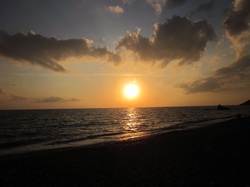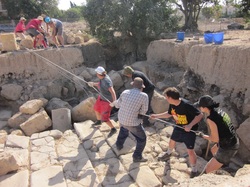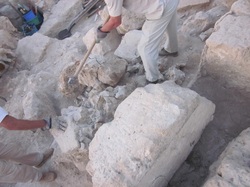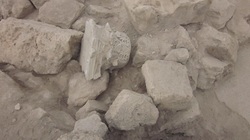As we enter our second week of the 2011 season, work continues in trench 11A under the Cypriot sun, removing the rocky fill above the nymphaeum. In the near distance, across the site the team is also hard at work in Trench 11B, as they continue excavation of the bedrock and the well from last year, and the extension of the medieval walls to the east.
Focusing on Trench 11A, the use of the bipod last week enabled the removal of a number of large rocks, making way for us to continue working through the tumble layer, and loosening more of the rocky fill. Breaking through patches of plaster proves difficult where some rocks were ‘cemented’ together as a result of the plaster seeping through the layer at the time of the fill. That, combined with a few patches of sandstone and, of course, the compacted nature of the tumble layer itself, has made it extremely satisfying to now see a significant drop in the layer.
So far, a number of architectural pieces have been uncovered, including a few architrave blocks, a couple of seats from the theatre, and a few half edged columns. These particular columns were perhaps originally a part of the north wall of the nymphaeum structure. These architectural pieces uncovered this season are in addition to the Corinthian capitals found in the same fill in previous years. It is interesting to note the difference in the stone and the size between the capitals – the larger marble capitals from the stage of the theatre compared to the smaller capitals of lesser quality stone, which were likely from the original structure of the nymphaeum. It is also interesting to note the wide variety of architectural pieces emerging in this tumble layer from various structures across the site, used as a location of deposit for storing architectural blocks of stone and rubble following the earthquake.
Today the bipod was again used to remove another dozen or so rocks. On a personal note, this brilliant piece of engineering was developed to remove blocks from the trench I was in last year (TR10C) so it is fantastic to have the opportunity to use it again. As always, a high degree of teamwork is demonstrated in placing the bipod in a suitable location, positioning the pieces to be removed, securing the ropes, aligning and positioning at the right angles, ‘pulling in’ and ‘letting go’ at the required time - all in order to safely move the large pieces of rock out of the trench. ‘All hands on deck’ enables it to be a continued success!
As work continues through the last bit of the rocky tumble, we are beginning to reach the next layer, or context, underneath – another step closer to exposing the mosaic floor.




 RSS Feed
RSS Feed